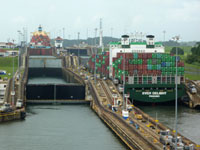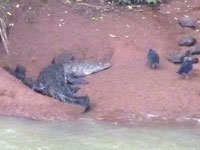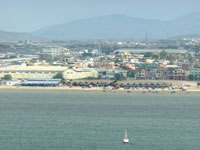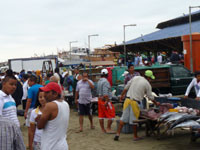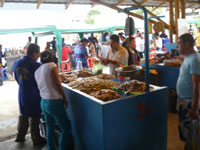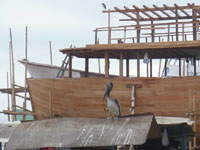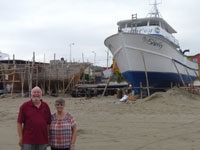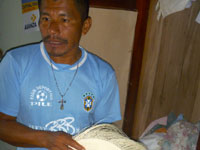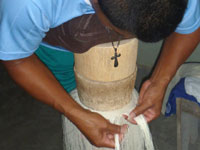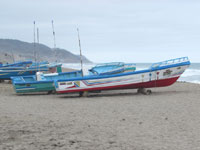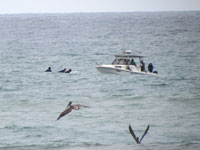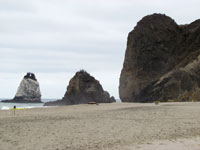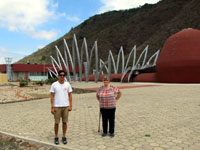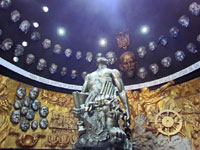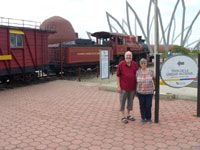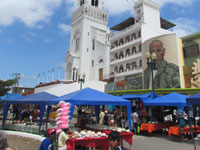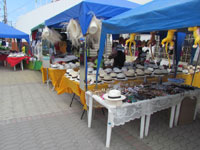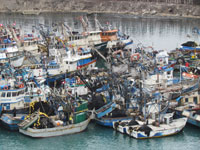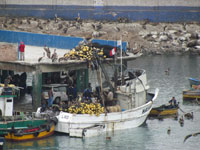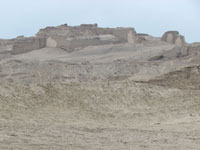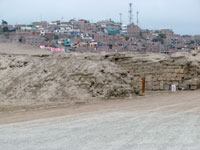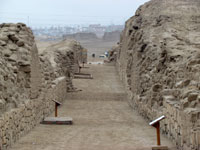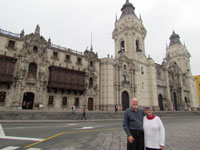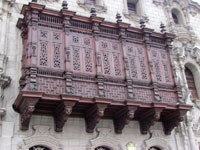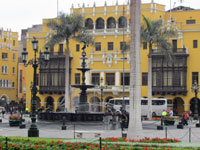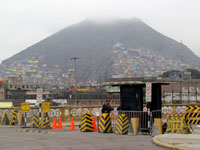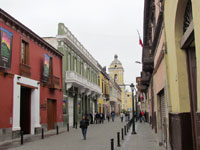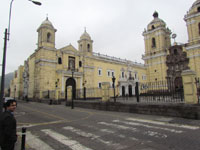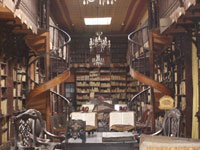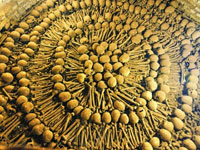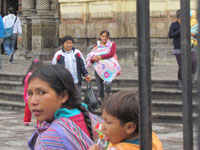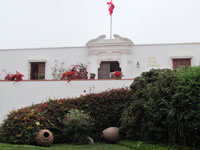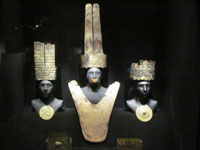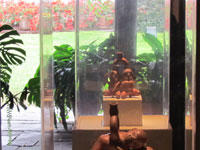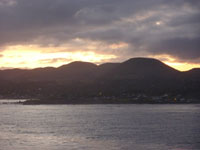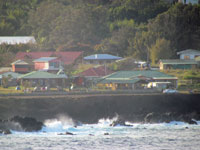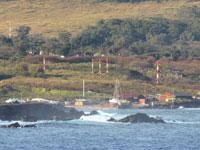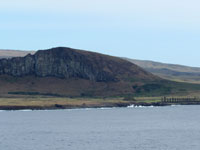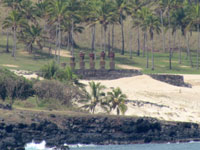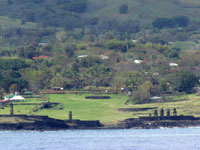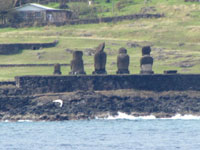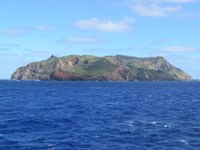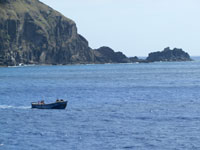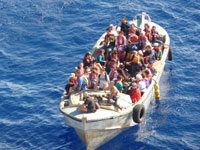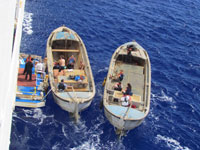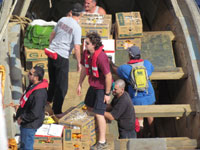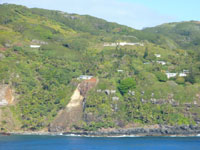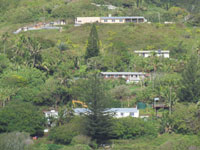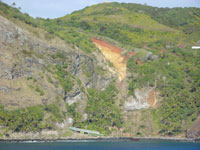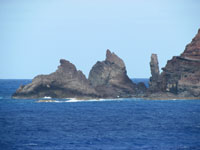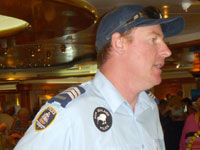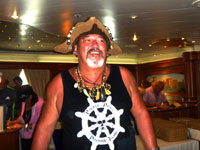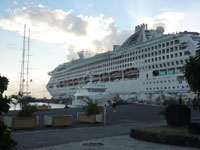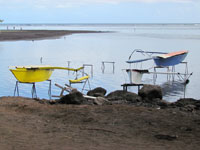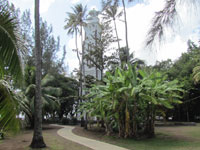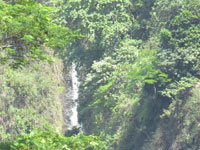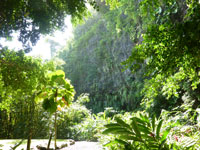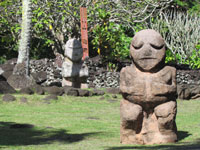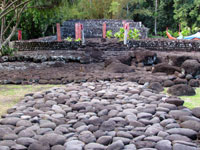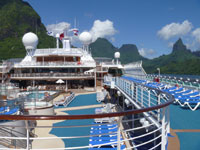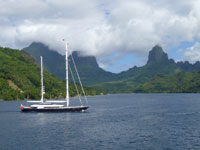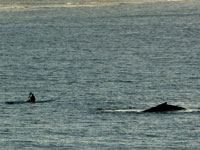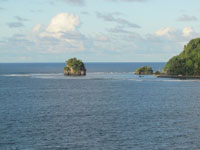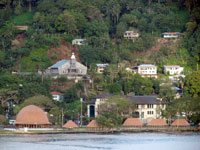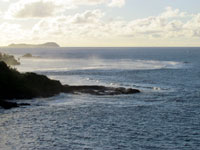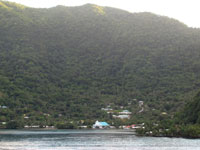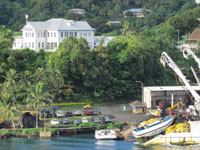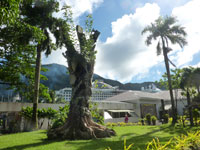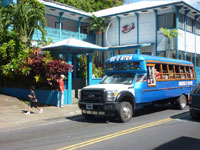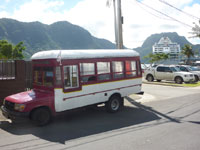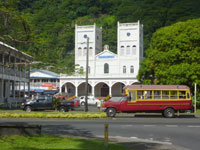A half-world cruise on Dawn Princess in July and August 2014 from Southampton
to Auckland :
Part Two - South Pacific
South Pacific (download 800KB PDF file) | Map | Cartoon
Part Two: From the Panama Canal to Auckland via South American coast and islands in the South Pacific Ocean
Panama Canal, Panama
We hope you enjoyed your sojourn in Gatun Lake, where we left you at the end of Part One, and will now take you through the remaining locks and out into the Pacific Ocean for the homeward bound leg of our journey.
We stayed on the revised schedule until we got to the narrow Culebra Cut which took over two hours instead of the one it should have taken. We were very late into the single Pedro Miguel lock and then sat for another hour before starting to enter the two Miraflores locks which would eventually lead us out into the Pacific Ocean. It took 11 hours to do the normally 8 hour traverse, but we finally made it and immediately started to feel more at home as we sailed into ‘our’ ocean!
For a fuller description of a transit of the Panama Canal and more photos, please refer to my Panama Canal blog of April 2011. There are also some excellent websites which explain the history and mechanics of the Canal and give lots of interesting details, maps and plans of the existing canal and the expansion. www.pancanal.com is a good place to start but there are many more if you just search for ‘Panama Canal’.
Once through the Canal it was a case of “Left hand down a bit” and we were on our way to...
Manta, Ecuador
We made it to Manta on time, though it was a shame the ship didn't celebrate the crossing of the Equator. However, we did get certificates acknowledging that we had passed through the Panama Canal on the 2014 World Cruise of the Dawn Princess!
We only had a day in Ecuador with the call that we made to Manta, in the coastal Manabi province. I think you will agree that we couldn’t have packed more into it if we tried! At 7.30am we met up with our driver/guide, a very nice young man with excellent English, called Gabriel, and we set off in the somewhat dilapidated car he had been allocated..
Our first call was at the beach in Manta where the fishermen brought in the night's catch (hence the early start) and all the restaurateurs and diligent householders gathered from 5.30am to buy the freshest fish. Tuna the size of a man and snapper weighing around 5kg were in plentiful supply, as well as huge squid and a variety of other, smaller fish, some familiar but others were strange, alien creatures in every colour imaginable. It was bustling and busy, with carts of fish and ice being wheeled about on the sands through the crowd. It was a wonder nobody got mown down, but then it's a daily occurrence so no doubt they are all used to it. We were transfixed and very impressed by the whole business.
There was also a covered fish market where retailers sold fish they'd bought from the guys on the beach - which I didn't really understand; why would anyone buy from them, at higher prices, if they could get the fish straight from the boat? Maybe they stayed open later to cater for the lazybones who didn't arrive until after the fishermen had left by 9am. By 10am there was no sign of commerce on the beach and it was taken over by families enjoying their Sunday off.
The fish market was understandably popular with the huge numbers of pelicans, frigate birds, boobies (a sort of large, clumsy gull) and terns, which are like shaggy grey herons rather than the pretty, white birds with red legs we are used to. One pelican in particular was well known as having adopted a particular stall as his own and he amused us by perching on the narrow top rail but very precariously, while he was posing for the camera. Pelicans are very graceful in flight but the clumsiest creatures when coming in to land, swaying and wobbling like a plane in a cross-wind. Just before touch-down they stick their legs out almost sideways and use their feet as brakes as they skid to a halt, like a child on his first bike - it never fails to amuse. (I apologise for the mixed metaphors!)
Just along the beach from the fish market is the last of the traditional boat building yards. The fishing boats are made of wood, with whole trees forming the fore and aft mainstays and carefully cut and shaped hardwood, such as teak, for the ribs and beams. The superstructure is made of marine ply, all hand cut and shaped. The photos show it better than words so I won't try to describe it further. We were surprised to learn that when these beautiful wooden craft are finished, they are completely covered in fibreglass and polished to a high shine so you would never know that they were so beautifully hand-crafted; we thought it a shame but these are working vessels and of course fibreglass is far more practical and requires much less maintenance than exposed wood. Because of the large amount of hand work and the type of timber used, the boats are very expensive and take many months to build - up to a year - and the modern, factory-built equivalent is half the price, so it is little wonder the art is dying out. In addition, it has proved impossible to get enough apprentices to learn the old methods as it is hard work and poorly paid.
We left the town and headed off into the countryside. We were surprised to find that the whole district is very dry and sandy, with scrub and cactus the main vegetation. Gabriel told us that when the rains came, in January, everything turned green within four or five days. They only get 300mm of rain a year at sea level, though there is rainforest higher up and it was to there we were heading. We drove up some not very high hills and were astonished as we came over the top to see the lush green grass, trees (including bananas) of the rainforest in front of us - no interim vegetation - arid desert to this in the space of a few metres. It also came on to drizzle as though determined to live up to its name. We had the option of an hour's hike through the forest, where we were promised the sight of howler monkeys and tropical birds but we decided against it as there were lots of other things we wanted to see.
The next stop was in a village called Pile (pronounced Peelay), which is a centre for the Panama hat making craftsmen and women. (Genuine Panama hats come from Ecuador, not Panama.) Because there were only two of us, the tour company had arranged for us to visit the best of them and that was a never-to-be-forgotten experience. His name is Simon and he is around 40 years of age. He had been making the hats since he was 12, having been apprenticed to his grandfather and father. He showed us how the hats are hand woven and knotted (no loom or anything like that), one filament at a time. The 'straw' is actually a particular type of palm leaf which is split and the white fibres stripped out. These come in different weights and they are graded with the finest going to the most expensive hats and the coarsest used for bags and cheap sun hats and mats for the beach.
The hat starts with a single knot made from eight fibres and is gradually built up in a circular fashion, each individual fibre being woven into the next. What is most telling of the effect this arduous and painstaking process has on the maker’s body is the posture that has to be adopted, so that the hats can be accurately knotted and woven by hand in a perfect shape. The base is the size of the hat being made and the blocks that Simon is leaning on are for other sizes. He has a small cushion to protect his chest but even so it is physically punishing work and, in common with the other hat makers, he suffers from chest pains and arthritic neck and back. He can work like that for four hours in the cool weather but then has to take a break for an hour then get back to it for another four hours. In the hot and wet season, however, he can only work for an hour a time and as it also makes the fibre more difficult to handle, he can only do about four hours a day.
Most ordinary-quality hats take about three months to make but Simon's take about a year and are of the very finest quality. He has an agreement with a very rich American, who owns a hotel in Hawaii where he sells the hats for up to US$20,000 each! Needless to say, Simon doesn't get all of that, but he gets US$2,000 per hat and an annual retainer to ensure he doesn't work for anyone else.
The village itself has no paved roads and all the houses are very rickety and rough-hewn, made variously of breeze-block, wood or corrugated iron. Many had palm-frond roofs and almost all had 'wee houses' made of palm fronds, with curtains of the same preserving modesty. Primitive doesn't begin to cover it, and this is a relatively prosperous village, as most households had at least one person making a living from hat making or weaving. There is oil in Ecuador and the oil companies are obliged to make some social contribution so they have set up a hat making school in the village, which is the flashiest building for miles and an all-round good thing, but I couldn't help wishing they'd spent some money installing indoor plumbing to the villagers’ houses as well.
From Pile we drove to the fishing village of San Lorenzo where as well as stopping for refreshment, a beer for Martin, Lipton Iced Tea for Gabriel and blackberry juice for me (US$2.80 the lot). We enjoyed the fresh sea air and admired the rocky outcrops, islets and caves at the end of the beach. The beach is also a nesting area for turtles, all the nest sites carefully marked off to avoid accidentally treading on them, but sadly it was the wrong time of year to actually see any turtles. We were told that this area is second only to the nearby Galapagos Islands in size and number of these delightful creatures. We did see lots of vultures and piglets enjoying the largesse of the town rubbish dump, however. There is also a traditional red and white lighthouse. We think we saw a whale while looking out to sea but cannot be sure; we know they are around there and this is the right time of year so it isn't unlikely.
We then drove to the mountain town of Montecristi, where we were first taken to Ciudad (Spanish for City) Alfaro. This is somewhat misleading as it isn't a city but rather a complex of museum, mausoleum, convention hall, and handicraft exhibits. There is also one of the first steam trains in Ecuador - now decommissioned. Eloy Alfaro was a revolutionary fighter who mobilised the peasant classes against the church and landowners and became the first president of modern Ecuador. Alfaro’s mausoleum was a giant model of the earthenware funeral jars in which the people were buried, along with their possessions. This one held a huge statue of Alfaro engaged in his 'struggle' and round the walls were carvings, most of them covered in gold leaf, showing the history of Ecuador and how he changed it. No one could say it was beautiful but it was certainly magnificent. The museum was small and consisted mostly of paintings and photographs depicting the class structure and history of Ecuador and its eventual transformation into what it is today.
From there we went down the mountain into the 'Panama Hat' town of Montecristi where we bought a hat each, but at US$25 (reduced from US$50 in a 'sale'), so not quite the quality of Simon's. They are much finer than many we've seen in Europe and are genuinely handmade, albeit in 'only' 3-months rather than a year.
We walked off our late, bargain-price, lunch in the small craft market which had taken over the town square in front of a huge church. The market had all the usual tourist stuff (and lots of hats of course) but the interesting thing about it is that the stall holders had come to town from the hills, hundreds of miles away, by bus, because they knew there was a cruise ship in, which gave us an idea of how desperate they are for trade.
A couple of days at sea, whale watching and relaxing, brought us to Callao, the port for Lima. Before arriving, however, Princess, the cruise company, went out of their way to scare the living daylights out of the passengers by sending letters to every cabin stressing how dangerous Peru is and not to go out alone for fear of being robbed or shot. Obviously one knows that one should be careful and not go off in a 'pirate' cab at the dock gates, but licensed tour operators are perfectly safe.
We had booked our local tours with a reputable, government-licensed organisation with good references on various sites like Trip Advisor, etc., so felt perfectly confident. Martin contacted them to say the ship had told us that it was unsafe around the dockyard gates, where we had arranged to meet our guide as non-official vehicles aren't allowed onto the quayside. They told him it would be fine, they would get there early and anyway this always happened every time a cruise came in, regardless of which line it was.
Lima, Peru (Day One)
We had an amazing time in Peru and certainly packed a lot into the two days that we had there. On the first day, Edward, our guide, was there to meet us at the dock gate, so no fears about being mugged while waiting for him. He is a very nice man with a wife and son aged two. The car was a fairly new Chevrolet Cruze and very comfortable; quite a difference from Gabriel's car in Ecuador.
We drove though the outskirts of the city, south along the coast road, for about an hour until we came to the ancient ruins of Pachacamac. These date from around 500BC and although there is evidence of their culture, they pre-date the Incas by many centuries. There are many fine examples of pre-Incan artisan work, pottery and even very finely woven textiles in ornate patterns. The colours are mainly red (from animal blood) and yellow (from grinding the sandstone rock to a paste) though other plant and earth dyes also feature to a lesser extent.
The Incas didn't appear until around the Middle Ages and actually only ruled for a very short time. This was a surprise as we'd always thought they were the original Peruvian civilisation and had been there for thousands of years. Edward told us we were not alone in this and the vast majority of tourists are as surprised as we were. The area covered about 500 hectares and the brick walls were very well preserved because they were covered in sand for hundreds of years and undisturbed by wind or rain (Lima gets about 4cm a year, most of it winter drizzle not a proper soaking). I can't remember all the facts we were given about the different style of building, but various civilisations laid the bricks horizontally, sideways, in big blocks or small ones.
Archaeologists believe that, historically, Pachacamac is arguably more significant than Machu Pichu. However, it is not nearly as spectacular and neither is it in such a breathtaking setting; as you can see from the photos, green and jungley it's not.
There is one part of the site which does feature some fairly lush vegetation and that answered our question about how such a dry place could support a population. There are rivers which never run dry and the ancient peoples knew enough to build along the river courses. It puzzled us how there could be rivers in a land with almost no rain and we can only assume they rise in the mountains far inland and run for most of their course underground.
While we were at Pachacamac, we saw some of a unique breed of horses, only found in Peru. They have a very dainty gait, almost dancing, which looks very odd but is very comfortable for the riders as they hardly bounce or move at all and riders can travel all day without fatigue (one hopes that applies to the horses, too).
Peru is a mixture of very poor and very wealthy, all of whom seem to
have an eye to the main chance. When the archaeological site at Pachacamac,
which is still being actively excavated, was first discovered it was very
remote from the city so workers were given permission to pitch their tents
actually within the restricted site. These 'tents' have since been improved
upon and altered until, lo and behold! there is a whole suburb of brick-built
houses climbing the hill at the foot of which the site lies. As no-one
thought to make the tent permits for a finite time, the owners of these
properties can claim the right to be there ... hmmm, I doubt that argument
would work anywhere else in the world.
After the morning at Pachacamac, we went into the city and had a drive-round
of some of the neighbourhoods, including the old town centre which is
now a Bohemian arty enclave. We said we would like some coffee and Edward
said he'd take us to his favourite cafe. As we walked along, we appeared
to be making for a Starbucks and I was just thinking "Don't say anything"
when Martin said "Oh, Starbucks!". Edward laughed and said "Yes,
but don't worry, that's not where we're going." Phew! We went to
a very good cafe in an old 'shop house' (much like Singapore) where we
had the best coffees ever.
Another drive through the city brought us to the very prosperous suburb of Miraflores where there were still some elegant houses but most had been sold and demolished so that multi-storey blocks of flats, each one costing a king's ransom, could be built on the land. The very modern and upmarket Larcomar complex has amazing views and excellent restaurants for lunch but the shopping (Chanel, Dolce & Gabbana etc.) was a bit rich for our blood. We could see the whole coast of Lima and the tremendous stretch of new parkland being cultivated for public entertainment and recreation; all artificially irrigated as there is virtually no rainfall. Ironically, given that the terrain is principally grey sand, the beaches are of imported golden sand - I guess the grey stuff isn't very inviting.
Our late lunch was had at a nice restaurant clinging to the side of the cliff, where we had a 'light snack'; we had forgotten how much the South Americans like their food. My country salad (chicken, artichokes and lots else) came in what can only be described as a beautiful white china wash basin and Martin’s panko prawns and quinoa was just as huge. Edward's sandwich would put Subway's finest to shame and his pile of home-cut fries was a meal in itself. Edward told us that quinoa is a Peruvian staple but that the price had quadrupled since western celebrity chefs had discovered it.
After lunch, we visited one of the Indian, or Inca, markets, which abound in Lima - all selling a huge variety of wool, alpaca and silver goods. To be honest, most of it was superficially attractive as the colours were bright and there were one or two novelties which amused us but once we started looking to see if there was anything we would like to buy, we drew a blank - except for very cheap and cheerful novelties for our grandsons.
Both days we were in Lima it was very dull and overcast, which is apparently quite normal in winter because of the effects of the Humboldt Current. This cools the water which then combines with the warmer air (not all that warm when we were there) to make a sort of sea fret; we thought it would be very depressing to live with it all the time but the locals didn't seem to be affected by it; they do worship the sun whenever it does appear, however.
We got back to the ship in one piece after a thoroughly enjoyable day and looked forward to the Peruvian folklore show on the ship that evening and the next day - we were glad we had the two day stop as there's so much to see and the traffic is so gridlocked that just getting from place to place took forever.
Lima, Peru (Day 2)
Wanting to make the most of our shorter second day, we were up early, met up with Edward at 8am and made straight for the historic city centre of Lima. The traffic was predictably chaotic but an advantage of travelling our way is that we could weave in and out of back streets and by-ways, unlike the tour coaches which were stuck with it.
We first saw a square (hexagon really) of very elegant baroque style
buildings forming the six sides. These had been very expensive and opulent
apartments of the wealthy upper and middle classes but now housed the
very poorest people. In the 1990s a particularly vicious terrorist group
called Shining Path, which many of us will remember from newspapers and
broadcasts at the time, planted bombs indiscriminately around the city
- in fact it's a wonder there's anything worthwhile left standing.
Everyone who could afford it fled the city and moved into armed-guard
protected gated communities. They liked their new homes so much that they
never moved back into their abandoned buildings which have consequently
become very dilapidated and, inevitably, taken over by squatters. No doubt
when the economy picks up a bit a developer will come along to 're-gentrify'
the area, and these indigents will again become homeless but just now
it is an 'elegant' solution to a thorny problem.
We then went to the Plaza Mayor (main square) where we saw the very
ornate government buildings and presidential palace, archbishop's palace
and the cathedral. The architecture of the government buildings reminded
me a bit of the ones we saw in Vienna as they were equally ornate in the
baroque style. The archbishop’s palace is particularly beautiful and has
the finest balconies in the entire city. These are closed in with glass,
as you can see in the photos, and hang out over the street so that the
occupants can watch what's going on. They were mainly for the women as
in those days (the days of the Spanish Conquistadors) the women were veiled,
a hangover from Spain's Moorish period.
Lima is sometimes called the City of Balconies as so many buildings feature
them and they certainly make a striking impression. They are all in very
good condition because of the almost total lack of rainfall, which means
that the wood doesn't rot as it would in a damper climate. In the centre
of the square is a fountain dating back to the 17th century and still
working perfectly.
We were very lucky to see the square comparatively empty of people as
just when we were ready to leave, the first of the ship's tour buses arrived
and peace was well and truly shattered.
Although we didn't go in to any of the buildings on the square, we did
visit the San Francisco church and monastery just one street beyond. This
was fascinating and we loved looking at the architecture and cloister
gardens. However we could have done with fewer detailed explanations of
the various pictures and frescoes; especially as the church guide's English
was poor and she sounded as though she was gargling rather than speaking.
We were also able to see the interior of the church from above as we went up into the choir balcony and, for us, this was very special as a service was being conducted and the singing and organ music were quite lovely; we wished we could have stayed longer to listen. There was a lot more to see however, and first we were taken to the catacombs. Here we wended through low-ceilinged passages to see the many thousands of human remains. These were mainly femurs and skulls, which had been found there, monasteries being the official burial places for Christians for several hundred years, until it was outlawed about 100 years ago.
Our favourite part of the monastery, though, was the ancient library which reminded us very much of the Marsh Library we saw in Dublin. The library is world-renowned and contains about 25,000 antique texts, some of them predating the conquest. Some notable books are the first Spanish dictionary published by the Royal Spanish Academy and a Holy Bible edition from 1571- 1572 printed in Antwerp. Going from the sublime to the ridiculous, it claims to have been the model for Hogwarts in Harry Potter, or at least that's what all the guides seem to claim.
Unfortunately no photography was allowed inside (the photos here were found on the internet) but Digital Journal has an article with good photographs of the interior and exterior of the monastery, catacombs, ossuary and library.
Our last stop was the fascinating Rafael Larco Herrera Museum, quite unlike any other we've visited. The building used to be a hacienda (farm) which was bought by the founder of the museum to house his collection. He had found all the exhibits at his family farm on the coast and realising the importance of the collection had moved it to Lima. While we were waiting for our guide to finish with the previous visitors, we had a coffee in the museum's restaurant which took about 20 minutes. We were astonished to discover that the ships tours had been and gone in that time - it took us over an hour of very selective viewing to go round.
The museum concentrated on pre-Columbian, pre-Inca artefacts which were in an astonishingly good state of repair, again as a result of the dry climate, presumably. There were thousands of pots, many depicting erotic themes (a sort of pottery Kama Sutra) and also animals, people and themes from everyday life, including, alas, a very graphic depiction of a human sacrifice. There was also a treasury of gold and silver ware and jewellery, head-dresses and body plates. Everything was beautifully displayed and our excellent museum guide, who understood that we didn't need to know every detail of every exhibit, was adept at finding the most interesting items in each room and telling us their stories. She also took us to the museum's store room where about 40,000 other exhibits are stored in glass cases - far too many to put out but all important in their own way.
We were back at Callao port in plenty of time for a look at another Inca market set up inside the port but the ship's tour was an hour late, stuck in traffic.
Four days at sea took us to...
Easter Island, Chile
Well, we were up before dawn to go on deck and watch the sun rise over this mysterious and magical island. It was warm and balmy and as the sun rose it got warmer still and we all prepared to go ashore. Then came the dreaded announcement: in spite of the perfect weather we would not be landing because of the barely-perceptible 1 to 2 metre swells, which would make tendering a very dicey prospect, given the lack of a proper jetty or even platform upon which to disembark. You can imagine the disappointment.
The Captain was most apologetic and instead of landing he took us on a circular tour of the island by sea, about a mile off-shore. This was surprisingly interesting as we got to see the terrain of the whole island and its numerous volcanoes as well as, yes, some Moai, the mighty stone statues which are what every visitor to Easter Island has come to see. OK, we didn't see them close up or get to see the quarry and all the other sites and sights, but we can confirm that they do exist and even from that distance were quite impressive. We were able to take some reasonably good photographs on a long lens but of course nothing very detailed, especially as the statues face inland so none of the pictures show their faces, or the length of their ears.
We were sorry not to get up close and personal with them but that's cruising for you. Later the swells were much bigger, up to 4 metres, and we could see it would have been difficult to get back on the tenders and off them onto the ship. Apparently one shipload a few years ago got stranded and had to stay on the island, dossing down on islanders' floors until they could be got off next day, so we were quite reconciled to the Captain's decision.
Easter Island was to be the 'Crowning Glory' of our travelling career and it's hard to have spent so long away from home not to achieve it. For it to have been a case of 'so near and yet so far’ tested even my positivity and 'Pollyanna-ish' nature! However we had had a marvellous trip so far and seen such wonderful places and caught up with some lovely people, friends and family, that we couldn't think the trip was a failure; but we would have been a lot more philosophical if the weather had been awful.
However, the trip wasn’t over yet and we looked forward to Pitcairn Island, two days away, which we expected would be much like Easter Island but without the Moai.
Pitcairn Islands, British Overseas Territory
Well, how wrong can you be? Pitcairn was absolutely nothing like "Easter Island without the Moai"! We woke up to the sight of a mountainous lump of rock in the middle of the ocean, which we approached slowly but surely, watching whales on the way - Southern Humpbacks, we're told. There were quite a lot of them and as any sighting of these magnificent creatures never fails to delight, they got the day off to a terrific start.
The history of Pitcairn Island, from the landing by the Bounty mutineers in the 18th Century to the child-abuse trials of more recent years, has been well documented in dozens of books and websites, so I will not go into detail here. However, for a contemporary account of life on the island, I highly recommend Kathy Marks' book ‘Pitcairn Paradise Lost’ (pub: Fourth Estate, Harper Collins ISBN 978 0 7322 8254 7 pbk). She lived on the island for the duration of the trials and provides an excellent account of life on the island today and the tensions which arose and are, to some extent, still affecting the community as a result of the trials and ensuing legal and personal issues.
Landing on the island is a very precarious and strictly limited activity and we knew that we would not be able to go ashore. However, once we reached Pitcairn, the most remote inhabited island on earth, the locals came out to meet us, riding in their 'whalers' - nowadays deep, aluminium boats which more resemble old fashioned, over-sized bathtubs. They bobbed about like corks as they manoeuvred to come alongside and we felt quite queasy just watching them. Most of the 48 inhabitants of the island came on board, including all the children, who I gather had a marvellous time being shown round the ship, including no doubt the ice cream parlour and the Kids' Clubs - the like of which they will not have seen since the last cruise ship called.
In addition to huge amounts of souvenirs, they brought with them a good supply of island-grown mandarins the size of grapefruit, bananas and papaya and pineapples all of which were very welcome and delicious, as were the lusciously juicy passion fruit. In return they were given copious quantities of beer, Fanta and other soft drinks as well as some boxes of frozen food, the contents of which I couldn't identify. A year's supply of soft toilet paper was also sent across to the island but we assume this was ordered in advance as it is hard to imagine that we would have carried so much excess stock. Given the small size of the monthly supply vessel from New Zealand, the space taken up by the paper would be more useful for food and other essentials and I think it would probably be normal for visiting ships like ours to be asked to bring such commodities.
Many of the souvenirs were the usual 'Made in China' caps and t-shirts but there were also some quite nice carved wooden things but all very expensive and even though one would have liked to help their economy, it wouldn't have helped ours to have indulged. I did buy some stamped postcards, however, which would be franked on the island and despatched on the monthly supply vessel, when it arrived from New Zealand a fortnight later. No doubt it will be posted when the boat gets back to New Zealand. Silly, but it amused me to do it and actually, for stamp collectors, a franked, Pitcairn stamp is a prized possession! We were there on the 15th August and as I write this it is the 28th October and the cards have still not arrived; will we ever see them again, I wonder?
At first glance it is impossible to imagine how the island could support any community, never mind 48 souls, as it appears to be sheer rock faced mountains and cliffs, with a few palm trees and some jungle as you can see from the photos. It's the total opposite of the bleak and windswept low-lying topography of Easter Island The land is very fertile and the climate almost exactly the same as ours in the Far North of NZ, so they can grow all their own fruit and vegetables and also run some goats, though other meat is imported, frozen, from New Zealand.
The island is only two square miles (5 square km) in area, although it would be approximately ten times that if the mountains and cliffs were flattened; they keep very fit as you can't go anywhere without going up and down steep slopes! They have a few quad bikes now but until fairly recently all the goods had to be taken off the whalers onto a unique design of wheelbarrow that has a bar at the back so it can be slid down hills like a sledge. We were intrigued to see a big digger and can only wonder how they got it, and the quad bikes, ashore as there's no jetty or dock and everything has to be taken off the ships onto the whalers for landing - the pictures of the whalers will give you an idea of what a feat this is!
Pitcairn is jointly administered by Britain, of which it is an Overseas Protectorate and NZ, and all the youngsters (8 at the school at the moment) go to New Zealand for high school and university - it's a wonder any return given the temptations of 'civilisation'. It is hoped they come back bringing non-Pitcairn spouses with them to try and expand the gene pool, as every true local is related, back through 8 generations, to Fletcher Christian of 'The Mutiny on the Bounty' fame. As someone commented, "Their gene pool doesn't have a deep end".
We enjoyed meeting some of the people, one of whom gave a very interesting illustrated talk about their life today, though there was no mention of recent ‘troubles’ and it was very apparent that there is an agreement, tacit or otherwise, that a united front will be presented to all visitors.
The scenic circumnavigation of the island (twice as it was so small) gave us an opportunity to soak up the sunshine and admire the rich, royal blue of the sea. The wild coastline with huge crashing breakers and the caves and rugged rock formations was quite awe-inspiring and we could only wonder how those Bounty mutineers ever landed there.
Two more days at sea took us to...
Tahiti, French Polynesia
After a hot and dusty walk in search of the Avis car rental office, we finally found it - nowhere near the place shown on their website - a non-existent address! We eventually started out in our little Peugeot 107 and set off on out trip round the island of Tahiti. I had forgotten just how spectacular the mountains are, with their sharp peaks and razor-like ridges, rising straight up to the clouds from the valleys. They are thickly covered with rainforest but we were there in the dry season and so didn't suffer the torrential rain which can fall during the rainy season… though it wasn’t altogether the best season to be there, as we soon discovered.
Our first stop was Venus Point which is where in 1769, commissioned by The Royal Society in London, Capt. Cook and his team of scientists observed the Transit of Venus across the sun. This enabled them to calculate the distance between the sun and the earth. This resulted in a big improvement in navigation, by accurately calculating the observer's longitude; at this time, longitude was difficult to determine and therefore navigation was not always as precise as was desirable.
The Tahitians have made a bit of an attraction of the site, which is
a very beautiful bay. There is a lighthouse there now, built in about
1867 to commemorate the centenary of Cook's visit. The bay also featured
racks of brightly coloured outrigger canoes, presumably used by fishermen
but we also encountered a fisherman standing waist-deep in water casting
his net by hand, very close to shore.
Next on the agenda was the Arahoho Blowhole, which was thunderously noisy
but, although the waves and spray were quite dramatic, the swell wasn't
big enough to cause the huge gouts of water that sometimes occur ... wrong
time of year, apparently. It was a nice stop, though and we enjoyed seeing
what there was.
Onward to an area of three waterfalls, which are located on private land up a very narrow lane. We got a good view of one of them, dropping a huge distance but, alas, with not a very great volume of water; wrong season again, alas, we needed to be there in the wet to see it at its best. Martin went to see if the other two were any more spectacular and how easy they were to access but he was soon back to report that the path to all three was closed for fear of rock falls, so whether it would be worth making the trek or not was moot.
We carried on until we were halfway round the island and reached the township of Taravao, which is right on the narrow isthmus that joins Tahiti's big island, Tahiti Nui, to the little one, Tahiti Iti. They are two almost circular islands shaped like figure 8 on its side, with one circle of the eight twice the diameter of the other.
After lunch we headed on round the island to some gardens with a reportedly spectacular waterfall but skipped it as it's quite a trek and the waterfall would almost certainly not be at its best given our experiences earlier in the day. We carried on to a grotto which features caverns, huge ferns and more crystal-clear pools.
Our final stop was at Arahurohu Marae, which isn't quite the same as the maraes at home but is more of a traditional type of temple. It has been well restored and there are some good statues and carved wooden posts of the sort called pou in New Zealand; I don't know what they call them in Tahiti but that's what they looked like. There was also a different, flat sort which seemed to be made from planks, with a sort of tiki design cut out; each one signifies a different strength, like wisdom, love, bravery etc. The picture shows some of them on the main part of the marae. You can also see the smooth, evenly-sized rocks the marae was built from; apparently carted over 50km from the only place where they are found on the island. The whole marae was in a beautiful, well-kept garden setting with fabulous trees, colourful shrubs, bamboo, bromeliads and bushes. It was very peaceful and was obviously a place commanding respect as there were no souvenir sellers or drinks stalls etc.
We finally got back to Papeete mid-afternoon and checked the car back in to Avis, who kindly ran us back to the ship. We went on board for a quick cuppa and freshen up before heading for the shops. Vaima Pearls were still there and had as beautiful a selection as always but, sadly, their prices had risen sky high since the last time we visited. I did, however, get some very nice grey keshi pearl earrings, so our record of never having left the shop empty handed is still intact!
Back to the ship again for another freshen up (it was very hot and humid)
before setting off for the famous food caravans, called roulottes, for
dinner. There was a wonderful atmosphere and everyone was enjoying themselves,
including the roulotte owners who must have thought all their Christmases
had come at once, given the number of our fellow passengers who were trying
out this novel style of dining.
Making crepes and galettes for dozens of people on just two hotplates
in a small camper-van meant that meals took a while to arrive. There was
also a surprise for us just before our food was served: out of a cloudless
(we thought) sky; there was about 5 minutes of torrential rainfall - real
monsoon stuff. We suspect ‘Someone Up There’ was teaching us a lesson,
having heard us muttering about the lack of water in the falls etc.!
There was a Tahitian folkloric troupe doing a show on board in the evening but we've seen it at least three times before and although it is very good, we were too tired to stay up to see it again and were in bed by 10pm and asleep about 10 minutes later!
Overnight, Dawn Princess trickled across to...
Moorea, French Polynesia
We woke up to the most fabulous views in what must be the best anchorage in the world. We've been to Moorea three times before but it never gets old and it's about the only place on earth that we look at and say that there's nothing to beat it - not even in New Zealand. We had a leisurely start, watching the mountains, peaks and crags appear and disappear in the rapidly moving clouds as we had our breakfast. We decided on an easy day and as we had driven round the island last time we'd been there didn't feel any need to do so again. Instead, we enjoyed the tender ride to the village.
The usual market was there, selling pearls and shell jewellery as well as pareus, shirts and such like. Again, the prices have risen alarmingly and really pushed most of the stuff out of our price range although some people were buying, so perhaps we're just cheap! One stall had some beautiful white and grey keshi pearl necklaces which I would have coveted had they not been US$400!
We were back on board for lunch and spent the afternoon relaxing on the steamer chairs on deck, watching the clouds and mountains again. We were treated to a sail-past of a really beautiful super-yacht, which looked so right in such a setting. As we were leaving at 5 o'clock, the Captain reported a whale sighting on the port side. We were standing watching as we went through the reef and were lucky enough to see the whales (we counted two), apparently playing and cavorting with a kayaker who was quite close to them - closer than I'd have wanted to be. A man on board said this morning that he'd seen them as we sailed in. I was surprised they'd stay in the same place for so long (about 8 hours) but if the local humans are their friends and they obviously have no fear of them, why not?
Another couple of days at sea brought us to...
Pago Pago, American Samoa
We arrived at our dock by sailing up a long fiord, with steep, jungle-clad mountains coming right down to the sea on either side. A beautiful golden dawn was breaking over the mountains, lighting up the ever-present rain clouds over 'Rainmaker Mountain'; it was very obliging, however, and didn't dump on us as threatened. We passed many attractive villages all along the water's edge, most with spectacular and beautiful churches as the population is, in general, very devout.
The township we were docked in is referred to as Pago Pago but that's
actually round the bay somewhat and we were in Fagatogo. As the whole
area tends to be known as Pago Pago, though, it wasn't an important distinction.
By the way, it's pronounced Puhngopuhngo, with the two words running into
each other and a soft g not, Pango Pango as we'd been calling it - every
day a day in school.
We walked through the township, taking in the colourful market and also
passing the museum with its amazing, intricately carved tree in the front
garden. It was fun watching the chaotic traffic and especially the multi-coloured
buses - mainly old heaps, a number of which looked homemade, and almost
all of which were rusty to one degree or another - some with big holes
in the side. The taxis were hardly any better and some of the drivers
looked decidedly shady so we decided not to try to engage one for a ride
around the island. None of the taxis seemed to have air-conditioning and
we didn't fancy a couple of hours on hot, plastic seats with no fresh
air, as even having the windows open wouldn't have helped since it was
so hot and humid. As well as the street level entertainment, we wondered
how the many brightly coloured houses, which were built right in the bush,
high up the mountain sides, got there and how the inhabitants manage to
get to them as there didn't appear to be any roads or driveways!
Whether the island would be more American or Samoan in character was something we were curious to discover; we found it was delightfully relaxed and ‘Island Style’ rather than briskly efficient American. The shops in the town area where we were docked are very local and colourful but there are also larger, American stores further out by the airport where most people live.
All the people we encountered were very smiley and friendly. A smiling, toothless old lady in the market made me laugh when she admired my hat and asked where I'd got it. When I said Ecuador, she said "Oh Ecuador - very nice in Ecuador! Where is Ecuador?"
As we walked through the town I bought a couple of lengths of fabric for peanuts at one shop and also a dress and necklace for a few more peanuts at the market. We eventually arrived at the Sadie Thompson Hotel, which is famous as it was named after a local 'lady of easy virtue' who figures in a short story called 'Rain', by Somerset Maugham, which was made into a blockbuster movie back in the 1950s. She may even have operated out of the hotel but that's not altogether clear. Whatever its history, they served a perfect fresh lemonade and a local beer which really hit the spot, all in an atmospheric, shady bar with ceiling fans; most refreshing.
As we walked back to the ship we looked across the bay to the tuna canneries which are not a thing of beauty but which provide the main source of income for the island. We marvelled that the rust-buckets lined up in front of them unloading their catch could actually stay afloat, let alone be licensed. We were told that rather than talking about the weather, locals discuss whether it's a good tuna day or a bad tuna day. This has nothing to do with the quantity or quality of the catch but whether the canneries are operating and which way the smell is being blown. Fortunately for us it was a good tuna day!
Back on the ship, while idly looking out of the window, I saw a large
turtle surface, take one look around and dive down again. It was so swift
that I wasn't absolutely certain it was a turtle. Later, however, I read
that they frequently put in such brief appearances to see if anything
interesting is happening; a socking great cruise ship was obviously not
sufficiently interesting to detain him as we never saw him again.
After lunch, Martin went for a longer walk in the opposite direction from
the township and came to the site of an old hotel called Rainmaker Hotel,
which used to be a favourite of the 'rich and famous'. However, it went
out of favour, out of business and became derelict. The beach it owned
was a valuable asset in this area with very few beaches, so Sadie Thompson
Hotel bought it, and 'Sadie's By The Sea' was born.
He also saw some new buildings - shaped like the traditional domed-roof fales (houses) but made of modern materials; the main one, with beautifully carved pillars, seems to be a meeting hall of some sort but without any signs it's hard to know. Actually there are quite a few modern buildings with these roofs, as the people are determined to retain some of their culture and this is one way they can reference their traditional architecture.
There is much more to the island than we saw, including a large National Park with many hiking trails, and a Marine Reserve which offers excellent and strictly-controlled diving. There are some decent beaches, just not in the commercial area, or even nearby, but some people went to Sadie's By The Sea where they reported good food and swimming, both in the pool and the ocean.
After leaving American Samoa we steamed towards Auckland and home. The weather had been superb throughout the whole eight weeks of our holiday including the long sea journey home where the seas were smoother than we have often experienced.
It was a most enjoyable, instructive and never-to-be-forgotten 'Trip of a Lifetime'. We feel enormously privileged to have had the opportunity to see so many places and meet so many wonderful people, some of whom allowed us to enter their world and gave us insights we would never have gained without their friendliness and generosity. We will always remember them.
South Pacific (download 800KB PDF file) | Map | Cartoon

